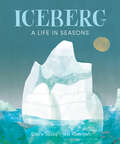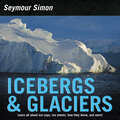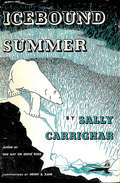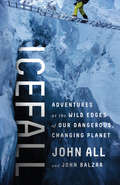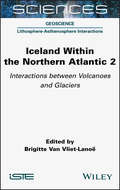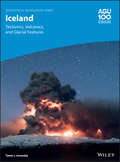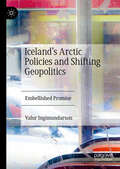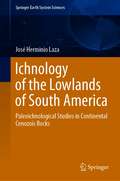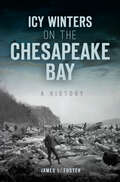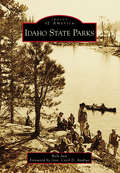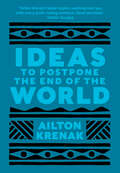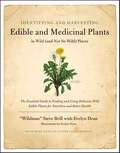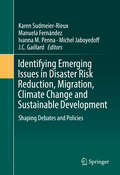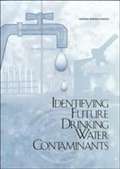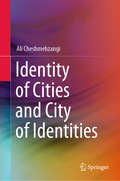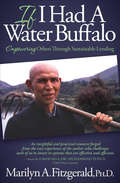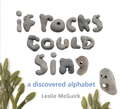- Table View
- List View
Iceberg: A Life in Seasons
by Claire SaxbyAn iceberg shears from a glacier and begins a journey that takes it through Antarctica’s seasons. Follow the iceberg in the spring as it watches penguins trek across the ice to their winter homes and senses krill stirring underneath the ice. With summer comes more life: the iceberg sees humpback whales spiral and orca gather. And the iceberg moves too, ever shrinking as the sun softens its edges and undersea currents wash it from below. When autumn arrives with cooling temperatures, the sea changes and the iceberg is trapped in the ice for the winter freeze. Then spring returns and the iceberg drifts into a sheltered bay and falls, at the end of its life cycle. But if you think this is the end of the journey, look closer — out in the ocean, an iceberg shears from a glacier and settles to the sea, beginning the process anew. Ocean, sky, snow and ice dance a delicate dance in this evocative portrayal of the life cycle of an iceberg. The poetic text and beautiful illustrations make this a unique nonfiction offering for young readers. This book ends with an author’s note explaining the effects of climate change on the Arctic and Antarctic regions, as well as a map and a glossary. Key Text Features additional information author’s note glossary map gatefold Correlates to the Common Core State Standards in English Language Arts: CCSS.ELA-LITERACY.RI.1.4 Ask and answer questions to help determine or clarify the meaning of words and phrases in a text.
Icebergs
by Grant R. BiggIcebergs are a prime example of an environmental phenomenon that brings together multiple disciplines in the polar sciences, from the physics of calving and melting to the geology of their solid deposits and sea floor interactions. Icebergs are also increasingly seen to play key roles in past and present climate change. This book gives a comprehensive, multidisciplinary view of icebergs and their interaction with the Earth system, from the physical and biological interaction with the ocean and climate, to how iceberg detritus informs us about past Earth history. Societal and cultural aspects of icebergs are also examined, in terms of the risks and opportunities posed by icebergs in the modern world, as well as how these might develop in the future. With extensive illustrations and key links to online resources, Icebergs is a valuable reference for academic researchers and graduate students studying oceanography, cryospheric science, climatology and environmental science.
Icebergs & Glaciers
by Seymour SimonIn this updated and revised edition of Icebergs & Glaciers, award-winning science writer Seymour Simon gives readers an in-depth look at how icebergs and glaciers have shaped our rivers, mountains, and earth, as well as the effect climate change is having on them and our planet. This nonfiction picture book is an excellent choice to share during homeschooling, in particular for children ages 6 to 8. It’s a fun way to learn to read and as a supplement for activity books for children.With fascinating facts and breathtaking full-color photographs, readers will learn all about how these huge masses of ice are formed, how they move, and why they are essential to our planet.This updated edition includes:author’s notestunning full-color photographsglossaryindexa list of websites and additional reading sourcesSupports the Common Core Learning Standards, Next Generation Science Standards and the Science, Technology, Engineering, and Math (STEM) standards.
Icebound Summer
by Sally CarrigharIn Icebound Summer, we are taken through a brief and intense arctic summer when seemingly frozen and lifeless tundra comes to life.
Icefall: Adventures at the Wild Edges of Our Dangerous, Changing Planet
by John All John BalzarJohn All has survived encounters with black mamba snakes, run-ins with wild jungle animals, and a brush with death in an icy tomb. No one knows the outer limits of our changing planet quite like him.In May 2014, the mountaineer and scientist John All plunged into a crevasse in the Himalayas, a fall that all but killed him. He recorded a series of dramatic videos as he struggled to climb seven stories back up to the surface with a severely dislocated shoulder, internal bleeding, a battered face covered in blood, and fifteen broken bones--including six cracked vertebrae. The videos became a viral sensation, an urgent and gripping dispatch from one of the least-known extremes of the planet.Yet this climb for his life is only the latest of John All's adventures in some of Earth's most hostile climates. He has also been chased by a wild hyena, scaled Everest, and narrowly missed being hit by an avalanche, all in pursuit of his true calling: the study of how we can master the challenge of our world's changing climate. Icefall is a thrilling adventure story and a report from the extremes of the planet, taking you to collapsing Andean glaciers, hidden jungles in Honduras, and the highest points on Earth. In this gripping account, our changing climate is not a matter of politics; it's a matter of life and death and the human will to survive and thrive in the face of it.
Iceland Within the Northern Atlantic, Volume 2: Interactions between Volcanoes and Glaciers
by Brigitte Van Vliet-LanoëThe volcanic island of Iceland is a unique geological place due both to its position in the middle of the Atlantic Ocean and its repeated glaciations. It has been an accurate recorder of geodynamic and regional climatic evolutions for at least the last 15 million years.This book studies the Quaternary magmatism associated with the deep Iceland hotspot and, in particular, its distinctive geochemical and volcanological characteristics. It also analyzes that Arctic glacierization as it relates to the opening of the North Atlantic and the appearance of today’s ocean currents. We will also investigate the Quaternary glaciation as it affected Iceland in its oceanic context, particularly on the basis of radiometric dating, looking at the formation of the Greenland and Scandinavian ice sheets and data from marine sediment. Finally, it explores the specific environmental features of the island, from the end of the last ice age to global warming today.This book brings together the internal and external geodynamics of our planet to understand how Iceland functions and its role as a recorder of the paleoclimatic evolution of the Northern Hemisphere.
Iceland: Tectonics, Volcanics, and Glacial Features (Geophysical Monograph Series #248)
by Tamie J. JovanellyExplore the dramatic forces that have shaped the Icelandic landscape over 30 million years Iceland’s formation and ongoing evolution offers a masterclass in geophysical processes. Iceland: Tectonics, Volcanics, and Glacial Features presents a regional guide to the landscape of this unique island. Accessible to academics, students, novice geologists, and tourists alike, chapters reflect the most popular way to explore the island, beginning in the southwest region and ending in the northwest. Volume highlights include: An overview of Iceland’s geologic history Exploration of the dynamic tectonic setting that has shaped the island Descriptions of landscape features of active and extinct volcanoes Discussion of the impact of glaciation in the past and present Techniques for monitoring geologic hazards Developments in harnessing geothermal energy The American Geophysical Union promotes discovery in Earth and space science for the benefit of humanity. Its publications disseminate scientific knowledge and provide resources for researchers, students, and professionals.
Iceland’s Arctic Policies and Shifting Geopolitics: Embellished Promise
by Valur IngimundarsonThis book examines the role of the Arctic in Iceland’s foreign and security policies from the end of the Cold War to the present. Based on extensive research and drawing on approaches from the fields of history and international relations, it shows that Iceland’s Arctic policies have gone through multiple phases during this period, all of which have been heavily influenced by external geopolitical factors, including its relationship with the United States, the 2008 financial crisis, the rise of China, and the Ukrainian crisis. It also demonstrates how Iceland’s strategic position in the North Atlantic has important repercussions for the United States, Russia and China. With an emphasis on geopolitics, nation branding, and governance, this book will appeal to scholars and students of Arctic policies, geopolitics and international relations.
Ichnology of the Lowlands of South America: Paleoichnological Studies in Continental Cenozoic Rocks (Springer Earth System Sciences)
by José Herminio LazaIchnology is the science of marks, tracks, trails, traces structures and other sources of evidence of biological activity, beyond the living beings themselves, when studied both in continents and oceans. In spite of its scientific value and interdisciplinary contribution, particularly in South America, in the complex task of identifying ancient environments, information is dispersed and sometimes even ignored. This book has recovered the remarkably abundant information that Ichnology of terrestrial environments has incorporated. The studied geographical regions are the Pampas of Argentina, vast lowlands with a wide latitudinal distribution in between the warm and wet subtropical areas and the cold deserts of Patagonia. Pedogenetic processes preserve tracks and marks found in sediments, rock surfaces and soils, revealing the activity of life forms. This book refers to a variety of signs of biological activity, particularly in ancient soils. This volume includes abundant original information and a meticulous revision of paleo-ichnological investigations, most by the author himself, one of the most important South American specialists, during many decades of his dedication to scientific research. The book includes a review of the stratigraphic sequences of the Cenozoic chronostratigraphic scheme. Firstly, the author provides a scrutiny of the continental ichnofacies and the ichnological record of the South American Cenozoic age. This is followed by chapters dedicated to the faunal associations of vertebrates, with very valuable information about the past climatic events and biogeographical changes, of undoubted value for those scholars interested in vertebrate Paleontology. Likewise, the highly relevant ichnotaxonomy is also developed exhaustively, with special reference to the essential activity of insects in the paleosols, mostly ants and termites.Finally, this book presents the most complete, extensive and up-dated bibliography in the subject, which is probably unique as such for southern South America and most of the world.Certainly, this is a book that will provide valuable scientific tools for those specialists interested in this infrequent discipline, either paleontologists, biologists, geologists, pedologists and sedimentologists.
Icy Winters on the Chesapeake Bay: A History (Disaster)
by James L. FosterSailing on the Chesapeake Bay's myriad inlets in summer, it is hard to imagine that, come January, icebreakers may be plowing the waters you cruised in July. When portions of the Great Shellfish Bay are iced up, the flow of commerce is impeded. At the turn of the nineteenth century, with the center of the new nation's government established it its arms, a frozen Bay meant that the United States' emergence to a status on par with the foremost nations of the world might be painfully slow. James Foster chronicles the disasters and pitfalls, large and small, that come with the coldest of winters.
Idaho State Parks (Images of America)
by Foreword By Andrus Rick JustIdaho’s state parks have been called the “jewels” of the Gem State. The story of how those jewels came to be involves political intrigue, much resistance, some philanthropy, and a touch of irony. Sen. Weldon B. Heyburn famously said that state parks were “always a political embarrassment.” Idaho’s first state park was named after him. Today, Idaho’s 30 state parks host five million people a year. Visitors come to boat, camp, bike, climb, hike, fish, and make memories in the great outdoors. This book tells the story of Idaho’s diverse state parks—from Priest Lake in Idaho’s panhandle to Bear Lake in the southeast corner of the state—through a wealth of historical photographs. A variety of parks are featured, including ones that were lost, found, or never came to fruition.
Ideas and Actions in the Green Movement (Environmental Politics #Vol. 2)
by Brian DohertyThe 'Western' green movement has grown rapidly in the last three decades: green ministers are in government in several European countries, Greenpeace has millions of paying supporters, and green direct action against roads, GM crops, the WTO and neo-liberalism, have become ubiquitous.The author argues that 'greens' share a common ideological framework but are divided over strategy. Using social movement theory and drawing on research from many countries, he shows how the green movement became more differentiated over time, as groups had to face the task of deciding what kind of action was appropriate.In the breadth of its coverage and its novel focus on the relationship between green ideas and action, this book makes an important contribution to the understanding of green politics.
Ideas to Postpone the End of the World
by Ailton Krenak“Ailton Krenak’s ideas inspire, washing over you with every truth-telling sentence. Read this book.” — Tanya Talaga, bestselling author of Seven Fallen FeathersIndigenous peoples have faced the end of the world before. Now, humankind is on a collective march towards the abyss. Global pandemics, extreme weather, and massive wildfires define this era many now call the Anthropocene.From Brazil comes Ailton Krenak, renowned Indigenous activist and leader, who demonstrates that our current environmental crisis is rooted in society’s flawed concept of “humanity” — that human beings are superior to other forms of nature and are justified in exploiting it as we please.To stop environmental disaster, Krenak argues that we must reject the homogenizing effect of this perspective and embrace a new form of “dreaming” that allows us to regain our place within nature. In Ideas to Postpone the End of the World, he shows us the way.
Identification and Mitigation of Large Landslide Risks in Europe: Advances in Risk Assessment
by C. Bonnard F. Forlati C. ScaviaLarge landslides affect many mountain valleys in Europe. They are characterised by a low probability of evolution into a catastrophic event but can have very large impacts on population, infrastructures and the environment. This impact is becoming more and more pronounced due to increasing tourism and the construction of new roads and railways in m
Identifying & Harvesting Edible and Medicinal Plants (And Not So Wild Places): The Essential Guide to Finding and Using Delicious Wild Edible Plants for Nutrition and Better Health
by Steve Brill Evelyn DeanIdentifying and Harvesting Edible and Medicinal Plants in Wild (and Not So Wild) Places shows readers how to find and prepare more than five hundred different plants for nutrition and better health. It includes information on common plants such as mullein (a tea made from the leaves and flowers suppresses a cough), stinging nettle (steam the leaves and you have a tasty dish rich in iron), cattail (cooked stalks taste similar to corn and are rich in protein), and wild apricots (an infusion made with the leaves is good for stomach aches and digestive disorders). More than 260 detailed line drawings help readers identify a wide range of plants -- many of which are suited for cooking by following the more than thirty recipes included in this book. There are literally hundreds of plants readily available underfoot waiting to be harvested and used either as food or as a potential therapeutic. This book is both a field guide to nature's bounty and a source of intriguing information about the plants that surround us.
Identifying Emerging Issues in Disaster Risk Reduction, Migration, Climate Change and Sustainable Development
by Karen Sudmeier-Rieux Manuela Fernández Ivanna M. Penna Michel Jaboyedoff J. C. GaillardThe proposed book is a timely contribution to researchers, students, scholars and policy makers in the fields of environment, human geography, development and disaster studies towards providing a more comprehensive grasp of contemporary development issues. Contributions include well-known practitioners and scientists that provide theoretical discussions as well as field observations regarding climate change adaptation, migration, disaster risk reduction and sustainable development linkages from around the world. One of the main barriers to furthering our understanding about the inter-linkages between these forces of development (or lack thereof) is the silo approach with which we address such issues. In spite of political talk about how to bridge gaps between climate change adaptation and disaster risk reduction, institutional architectures and frameworks maintain the divisions. The goal of this book is to explore these inter-linkages from a number of different geographical, social and natural science angles and contribute to the debate about how to improve disaster risk reduction (DRR) policies and practices, taking into account migration process from a large perspective where both natural and social factors are crucial and mutually "alloyed".
Identifying Future Drinking Water Contaminants
by National Research CouncilWith an increasing population, use of new and diverse chemicals that can enter the water supply, and emergence of new microbial pathogens, the U.S. federal government is faced with a regulatory dilemma: Where should it focus its attention and limited resources to ensure safe drinking water supplies for the future?Identifying Future Drinking Water Contaminants is based on a 1998 workshop on emerging drinking water contaminants. It includes a dozen papers that were presented on new and emerging microbiological and chemical drinking water contaminants, associated analytical and water treatment methods for their detection and removal, and existing and proposed environmental databases to assist in their proactive identification and regulation.The papers are preceded by a conceptual approach and related recommendations to EPA for the periodic creation of future Drinking Water Contaminant Candidate Lists (CCLs--produced every five years--include currently unregulated chemical and microbiological substances that are known or anticipated to occur in public water systems and that may pose health risks).
Identity of Cities and City of Identities
by Ali CheshmehzangiThis book explores the hybridity of urban identities in multiple dimensions and at multiple scales, how they form as catalysts and mechanisms for urban transitions, and how they develop as city branding strategies and urban regeneration methods. Due to rapid globalisation, the notion of identity has become scarcer, more fragile, and inarguably more important. Given the significance of place and displacement for contemporary everyday life, and the continuous advancement of technologies, identifying relations and values that define humans and their environments in various ways has become crucial.Divided into seven chapters, this book provides extensive coverage of ‘urban identity’, an often-overlooked topic in the fields of urbanism, urban geography, and urban design. It approaches the topic from a novel dual perspective, by exploring cities with tangible commonalities and shared strategies for refining their identities, and by highlighting cities and urban environments characterised by multiple identities. Based on a decade of research in this field, the book provides a multi-disciplinary perspective on urban identity. In addition to comprehensive information for students, it offers a key reference guide for urbanists, urban designers and geographers, architectural and urban practitioners, decision-makers, and governing bodies involved in urban development strategies.
If Bees Disappeared (If Animals Disappeared #1)
by Lily WilliamsWhat would happen if bees disappeared? Find out in this fourth book from Lily Williams in the award-winning If Animals Disappeared Series that imagines the consequences of a world without bees.The rolling hills and lush climate of Kent, England are home to many creatures.These creatures are fluffy, sneaky, spikey, and ... small, like the bee.Though bees are small, their importance is BIG. Today there are over 250,000 species of bees but all of them are in danger. Because of disease, pesticide exposure, lack of foraging habitats, and poor nutrition, entire honey bee hives are dying.What would happen if bees disappeared completely?Artist Lily Williams explores how such a loss would effect not just bees' environment, but the world as a whole in this poignant, beautiful book about the importance of our most important bees.
If Elephants Disappeared (If Animals Disappeared)
by Lily WilliamsWhat would happen if elephants disappeared? Trace the repercussions of a world without elephants in writer and illustrator Lily Williams' third picture book about loss and conservation.The Congolese forest is home to many types of animals. Some are strong. Some are slippery.Some are loud.And some, like the elephant, are BIG.The elephant has become synonymous with the image of African wildlife. They can grow over 10 feet tall and eat up to 300 pounds a day. While these giants are beloved figures in movies and zoos, they also play a large role in keeping the forest ecosystem healthy.Unfortunately, poachers are hunting elephants rapidly to extinction for their ivory tusks, and that could be catastrophic to the world as we know it.
If I Had A Water Buffalo: Empowering Others Through Sustainable Lending
by Marilyn A. FitzgeraldAn expert in fighting global poverty shares lessons from her travels and outlines a path to help impoverished people achieve self-sufficiency.Dr. Marilyn A. Fitzgerald has travelled the globe working to end world poverty through humanitarian aid and microfinance. With her unique opportunity to observe what works and what doesn’t, she set out to find a system that not only provides resources, but helps people thrive—a way that helps people build a foundation of dignity and self-determination.If I Had a Water Buffalo details Fitzgerald’s journey of discovery from the remote villages and cities of Indonesia to Eastern Europe, South America, Bangladesh, and beyond. Fitzgerald begins her book by recounting the ongoing cycle of visiting international humanitarian projects and then returning home to solicit the funds and resources needed to support those projects. Then, during a trip to a village in Indonesia, a man’s request for a water buffalo inspired Fitzgerald to find a better way.In If I Had a Water Buffalo, Fitzgerald shares the lessons she learned both in academia and in the world—lessons that can be adopted by businesses, institutions, schools, parents, and individuals seeking to help lift people around the world out of poverty.
If Polar Bears Disappeared (If Animals Disappeared)
by Lily WilliamsThe freezing ecosystem in the far north of the globe is home to many different kinds of animals. They can beStrong, like a walrusTough, like a lemmingResilient, like an arctic foxBut no arctic animal is as iconic as the polar bear.Unfortunately, the endangered polar bear is threatened with extinction due to rapid climate change that is causing the ice where it hunts/lives to melt at an alarming rate. If Polar Bears Disappeared uses accessible, charming art to explore what would happen if the sea ice melts, causing the extinction of polar bears, and how it would affect environments around the globe.
If Rocks Could Sing: A Discovered Alphabet
by Leslie McguirkAmazing rocks, found on a stretch of beach near the author's home, comprise this unique alphabet book. A is for Addition, and there are rocks in the shape of real numbers, too. B is for Bird, and there is a bird rock on a nest with an egg. G is for Ghosts, and there is a host of rocks that look like ghosts! Children and adults alike will pore over these fascinating rocks, and will be inspired collect their own.From the Hardcover edition.
If Sharks Disappeared (If Animals Disappeared)
by Lily WilliamsA healthy ocean is home to many different kinds of animals. They can be big, like a whale, tiny, like a shrimp, and even scary, like a shark. Even though sharks can be scary, we need them to keep the oceans healthy. Unfortunately, due to overfishing, many shark species are in danger of extinction, and that can cause big problems in the oceans and even on land. What would happen if this continued and sharks disappeared completely?Artist Lily Williams explores how the disappearance would affect other animals across the whole planet in this clever book about the importance of keeping sharks, and our oceans, healthy.
If Tigers Disappeared (If Animals Disappeared)
by Lily WilliamsWhat would happen if tigers disappeared? Find out in this fifth book in the award-winning If Animals Disappeared series that imagines the consequences of a world without tigers.Deep in the Biligirirangana Hills in India, a fierce creature roams. This landscape is home to animals that are slithery smart hidden and....LOUD like the roar of a tiger.There are nine subspecies of tigers, but three are now extinct. They play a very important role in keeping nature in balance. But, due to expanding human populations, poaching, and more, they’re in danger. What would happen if tigers disappeared completely? Join Lily Williams as she tracks the devastating reality of what our world might look like without tigers.
